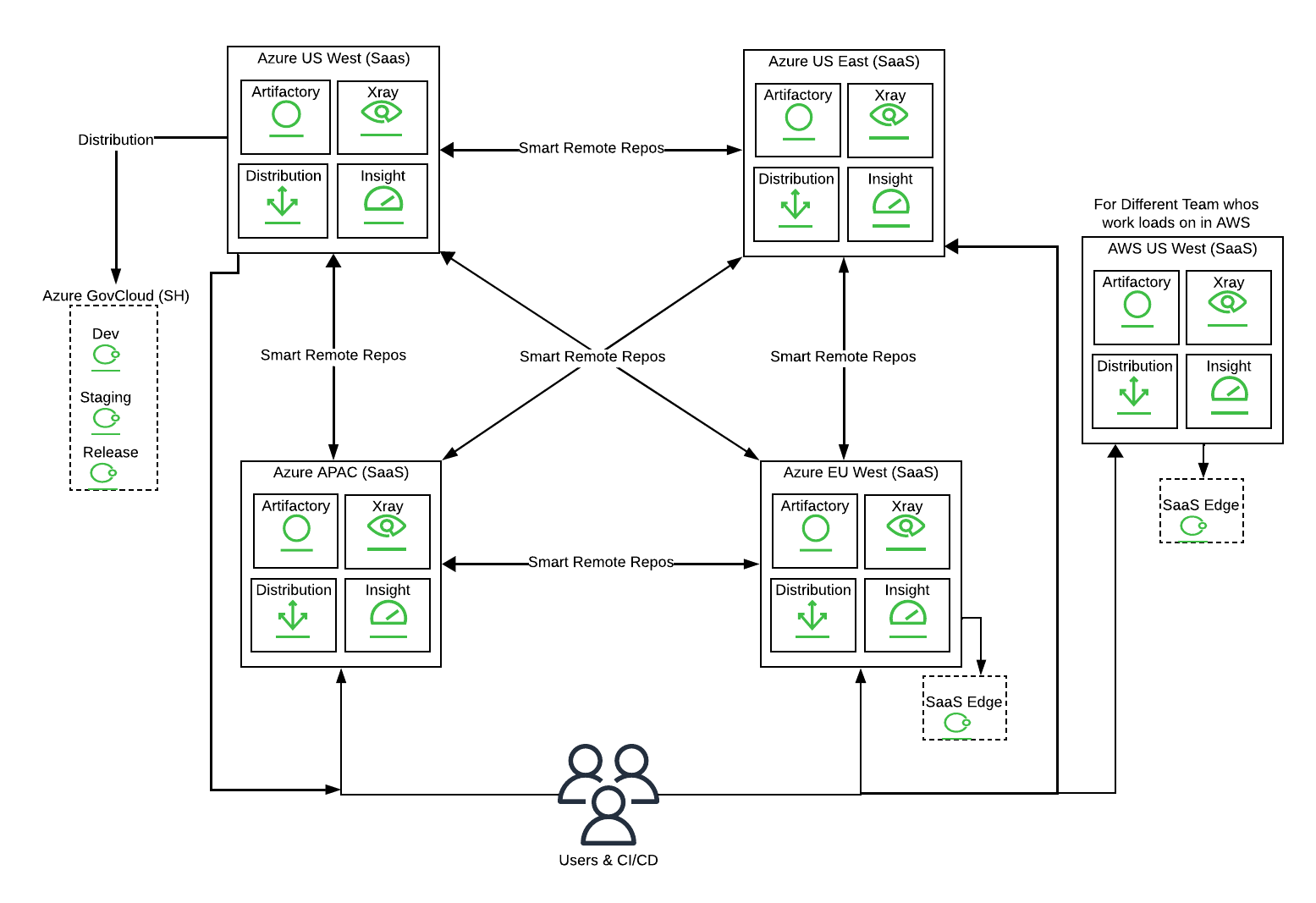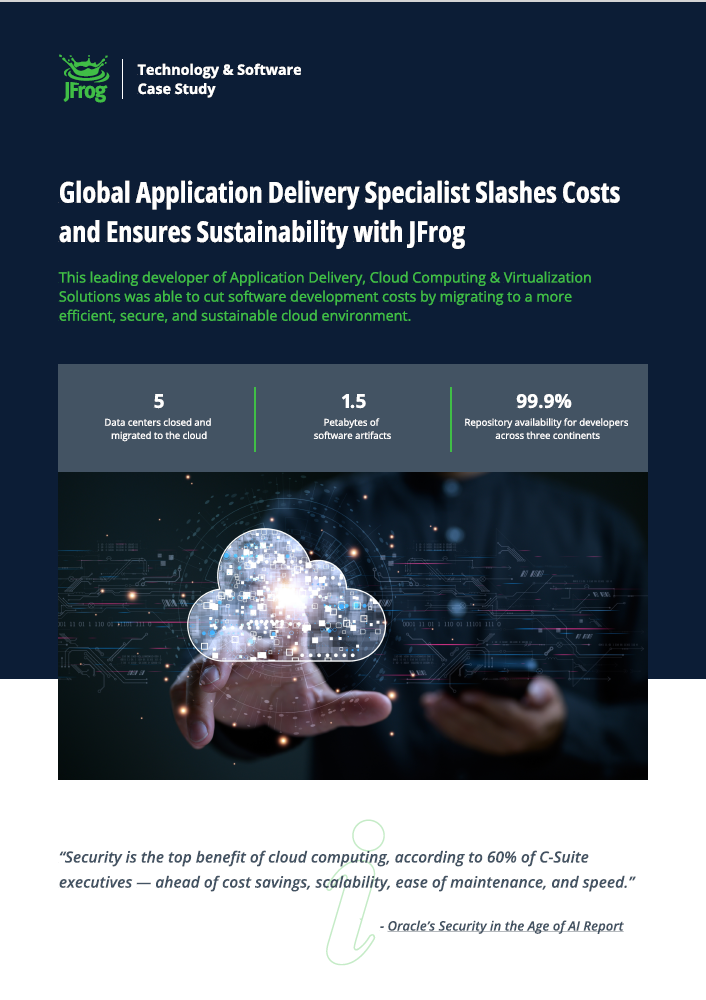Global Application Delivery Specialist Slashes Costs and Ensures Sustainability with JFrog
This leading developer of Application Delivery, Cloud Computing & Virtualization Solutions was able to cut software development costs by migrating to a more efficient, secure, and sustainable cloud environment
5
Data Centers closed and migrated to the cloud
1.5
Petabytes of software artifacts
99.9%
Developer repository availability across three continents
| Security is the top benefit of cloud computing, according to 60% of C-Suite executives — ahead of cost savings, scalability, ease of maintenance, and speed. |
Overview
According to Gartner, the public cloud will be used by the majority of enterprises for application software, infrastructure software, business process services, and system infrastructure by the end of 2025. So it becomes a question of not whether software development will migrate to the cloud – but rather when will an organization migrate its software development operations to the cloud.
That is certainly the case when it comes to this leading software developer, a global technology powerhouse specializing in application delivery, cloud computing, and virtualization, that is dedicated to enabling secure and efficient access to applications and data for organizations worldwide. As a leader in the information technology sector, the company optimizes digital workspaces and IT infrastructure through advanced virtualization, networking, and cloud technologies.
To provide these complex software solutions, the company relies on a large team of nearly 8,000 developers, located at five development centers that are spread over three continents. They used to have both physical data centers and some cloud infrastructure to store their huge 1.5 PB of software artifacts.
Challenges
According to Stream Data Centers, the average yearly cost to operate a large data center ranges from $10 million to $25 million. A little less than half is spent on hardware, software, disaster recovery, continuous power supplies, and networking, while the rest goes to applications, infrastructure, heating, air conditioning, property, and labor.
Outside of the significant cost of operating a large data center, another major constraint is the lack of flexibility when it comes to adding resources. So each time the system requires more CPU power, memory, or storage, DevOps are responsible for physically purchasing, installing, and maintaining more hardware.
This was a major obstacle both in terms of providing temporary resources for specific projects and the ability to quickly scale development resources according to business requirements. Likewise, the lack of resources often leads to system instability, slowing down the development process, increasing the time for each build, and frequent downtime.
To grapple with these challenges, the DevOps team analyzed various computing environments, calculating that the company stood to benefit from significant cost savings by moving development operations from on-prem to the cloud. With those figures in hand, they held meetings with the executive leadership and received full backing for a plan to close down their data centers and move all development operations to the cloud.
Once the decision was made to move to the cloud, immediate challenges included:
- How to move the massive 1.5 Petabyte of artifacts to the cloud
- Completing the migration in the allotted 18-month timeframe
- Making the move with minimal impact on developers and to CI/CD pipelines
- Maintaining high availability and seamless authentication
- Enhancing shift left security without affecting the development workflow
It was decided that a SaaS model, rather than a self-managed private cloud configuration, was the most suitable for sustainably expanding development organizations, taking into account the company’s limited DevOps resources.
Solution
To implement the plan and overcome the challenges, the DevOps team needed to bridge the gap between their current on-prem and the future SaaS-based development environment. They believed that the JFrog Platform which they already deployed for their on-prem operations, would be the best solution for migration and managing future cloud operations, as JFrog Artifactory can be deployed on-prem, in the cloud or using a hybrid model.
Working closely with JFrog Professional Services, they were able to overcome DevOps and IT manpower challenges and quickly bridge the knowledge gap that existed around implementing cloud-based software development environments.
JFrog’s ongoing partnerships with Azure, the cloud vendors selected to provide the infrastructure, and their ability to provide a proven integrated solution, also gave the DevOps team confidence to accelerate the migration and move to a SaaS-based development environment as soon as possible. Likewise, keeping the migration transparent to developers was also a key consideration, as they would be using the same familiar JFrog interface and most developers would barely notice moving to the cloud.
The plan was to consolidate the 5 existing data centers across three continents, into 4 cloud-based JFrog Artifactory Instances. In order to overcome the challenge of transferring the 1.5 PB of data, each data center would be migrated separately, breaking up the size of the repository between 100 – 400 TB each.

To support multi-site development and deployments, including migrating Release Bundles, JFrog Distribution was utilized, as well as the platform’s scalability features and ability to handle large volumes of data. In terms of replication, JFrog Professional Service leveraged JFrog’s Smart Remote Repository technology which supplies cached remote artifacts as they are needed rather than inefficiently federating such large repositories and incurring higher storage costs. Using the Multipart Transfer feature, even repositories of 400 TB were transferred quickly and efficiently.
Another key accomplishment to ensure customer success was the JFrog Platinum Support team’s ability to handle the actual move to a SaaS environment and initiate deployment with a single CLI command. Platinum Support Service, means all critical issues are addressed in thirty minutes or less. In addition, on migration day, a JFrog team was dedicated to monitoring the system in real-time and mitigating any issues on the spot.
The final step of the migration took less than half an hour, depending on how long it took for the DNS to update. More importantly, from the development team’s perspective, the last phase had minimal impact on development operations.
Results
Through proper planning and implementation, the results were better than expected. Even though 18 months were allotted to complete the migration, DevOps was under pressure to get it done earlier. The JFrog Professional Services team executed the migration plan with a high degree of professionalism and efficiency, enabling them complete their milestones ahead of schedule and giving Citrix DevOps team the confidence that the project could actually be completed ahead of schedule.
When considering the average cost of running a data center it is the neighborhood of $1.5 M per month, multiplied by 4 data centers, then it’s clear the economic incentive for closing up the data centers and moving to the cloud ASAP.
With the cloud environment up and running, the DevOps team immediately noticed the change in going from self-hosted instability and bottlenecks to SaaS scalability and flexibility. Some of the immediate benefits include:
| Benefit | How it Works |
| Accelerated migration | Cutting implementation by six months resulted in significant cost savings by shutting down data centers. |
| Faster build times | Additional resources, fast access to artifacts, and automated security scanning significantly reduce build times and faster releases. |
| Improved developer efficiency | Platform-wide authentication and remote access to all artifacts enable developers to concentrate on coding instead of admin activities, increasing productivity. |
| Enhanced security | Increased resources enable the automation of repetitive security tasks to increase consistency and improve security posture. |
| High availability | Smart Replication across regions gives developers access to all artifacts from multiple repositories with 99.9% uptime increasing their productivity. |
| Scalability | Transitioning to a SaaS environment enabled the ease of dynamically adding resources, including auto-scaling based on workload demands |
| Cost savings | The DevOps team estimated that moving software development from on-prem to the public cloud would result in a 40% cost savings. |
| Long term sustainability | Moving to a SaaS model enables adding additional resources, enabling scalability according to business requirements. |
The decision to migrate to the cloud was not just about short-term cost sayings, but rather selecting a platform that was sustainable for the company’s growing needs in the mid to long term. By selecting a SaaS model, DevOps was confident that the platform could scale to meet their growing requirements for adding more developers, speeding up the release cadence, and enhancing security, as opposed to relying on internal teams and their limitations in providing additional resources for self-hosted instances.
From a security perspective, extensive automation of security tasks using JFrog Xray has made scanning components, binaries, containers, libraries, and dependencies for vulnerabilities and license compliance issues incredibly developer-friendly. This approach streamlines developer security workflows and simplifies incident response by providing step-by-step remediation and impact analysis from a single source of truth for all software artifacts.
The dedicated support provided by JFrog Professional Services was also a critical component for ensuring the success of the migration and continual improvement in ongoing operations. Even post-implementation, the DevOps team and JFrog Customer Success are still working closely to improve efficiency, leverage advanced features, and detect vulnerabilities to ensure the highest quality and security of their software.
The JFrog Software Supply Chain Management Platform
By implementing migration and managing ongoing cloud operations using the JFrog Platform, this leading enterprise software developer successfully addressed its challenges for migration to the public cloud, speeding up build times, enhancing security, and cutting the cost of operations. The JFrog professional services team helped guide them, every step of the way, in transitioning from their on-prem environment to a SaaS model without affecting their developers’ ability to deliver solutions for their customers.
We invite DevOps and security professionals from the technology sector to schedule a demo or take an online guided tour and see how the JFrog Platform changes how enterprises develop software in the cloud.
Products
JFrog Artifactory, JFrog Xray, JFrog Advanced Security, JFrog Curation, JFrog Catalog
Partners
Azure
Services
Professional Services – Platinum Support
Additional Resources
White Paper: Replication: Manage Binaries Across Multi-Site Topologies
Solution Sheet: Get Ready for High Availability
White Paper: Artifact Management: Best Practices for Scalability and Growth





